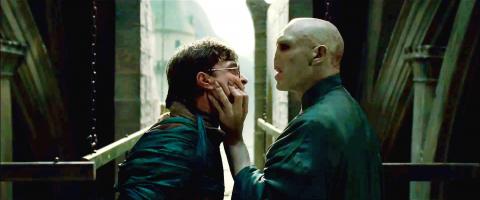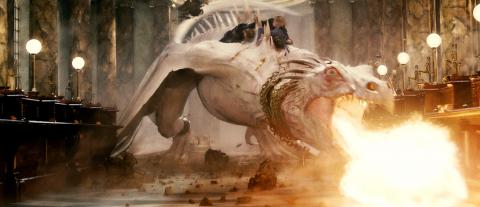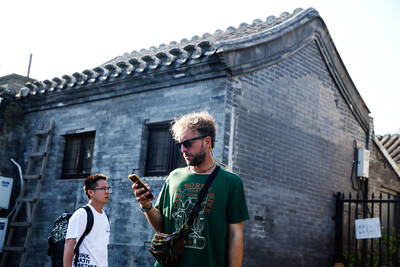It was a remarkably satisfying conclusion to the Potter franchise earlier this week at a 3D press screening at the Showtime Cinema on Linsen North Road in Taipei, but the excitement among the crowd of media and movie industry workers was considerably more muted than the very palpable anticipation of the much more massive crowds that were present for the first screening of Transformers: Dark of the Moon last month.
As has been pointed out more than once, those invested in the Harry Potter series will not want to miss this final installment, but given the serpentine intricacy of a plot developed over eight long feature films, those who aren’t probably couldn’t care less. The release in 3D for this last installment was an unnecessary piece of froufrou that was wholly inadequate to capture the interest of those whose only interest is in witnessing the latest cinematic spectacle.
So, disposing of the 3D issue, for anyone who has given the Harry Potter series any attention over the past decade, the finale has everything that one might hope for. It is conceived on an epic scale, and climbs on the shoulders of the more pedestrian and difficult Deathly Hallows: Part 1, drawing the story to a conclusion that is suffused with melancholy. Many characters who played major roles in previous films are given cameos, almost as if taking their curtain call, and many details of the plot are explained.

Photos courtesy of Warner Bros Entertainment
With its wealth of detail and picking up themes from many of the earlier installments, this final chapter is likely to get many people returning to the series to follow it through once again from the beginning.
The film is unabashed about leaving behind anyone who hasn’t boned up on their Harry Potter lore, diving into the complex endgame of the story with a minimum of preamble. This has been the policy of David Yates since he took over with the fifth Potter movie (Harry Potter and the Order of the Phoenix in 2007), and on the whole it has paid off, giving him more time to craft an appearance of depth and body to J.K. Rowling’s convoluted mythologizing. For newcomers, it makes the film all but incomprehensible. It must be said, that with its oodles of Gothic atmosphere, high melodrama and some clever effects, the film provides a visual feast that helps carry the audience along even when aspects of the narrative may be far from clear.
The three main characters, Daniel Radcliffe (Harry Potter), Rupert Grint (Ron Weasley), Emma Watson (Hermione Granger), for all the hype that surrounds them, have been given parts that are underwritten, and Potter’s charisma is not particularly evident in Radcliffe’s rather shuffling performance. There are, of course, the romantic resolutions, and the big kissing scene between Potter and Ginny Weasley (Bonnie Wright), and also that between Ron and Hermione, seem unearned and cheesy. Yates is better with the dark side of the conflict, and doesn’t shy away from showing the death of much-loved characters as the cost of victory.

Photos courtesy of Warner Bros Entertainment
A few cameos put the still immature talent of the stars in a startling and not particularly welcome perspective. An early scene with John Hurt as Ollivander, the maker of wizarding wands, provides some exposition about the importance of a certain magical artifact. It is a rather thankless role that Hurt manages with superb conviction, and even playing a shriveled old man, his screen presence overwhelms Radcliffe’s heroic efforts. It is splendid to see Maggie Smith letting her hair down as a re-invigorated professor Minerva McGonagall, but other fine actors, Ciaran Hinds and Kelly Macdonald in particular, are little better than extras.
Yates manages the pace of the film extremely well, and the denouement comes as a relief after the painful and sluggish buildup in Deathly Hallows: Part I. There are numerous loose ends, but this doesn’t matter all that much, for Yates has got fully to grips with the main points of the narrative, and barrels ahead, hardly leaving his audience time to catch breath. On the other hand, the set is full of little nuances that will keep Potter fans involved for repeated viewings, delighting in spotting some nice little detail here and there, and acknowledging that the director, for all his determination to bring the big show to a rousing close, has not ignored the finer points of the story.

Climate change, political headwinds and diverging market dynamics around the world have pushed coffee prices to fresh records, jacking up the cost of your everyday brew or a barista’s signature macchiato. While the current hot streak may calm down in the coming months, experts and industry insiders expect volatility will remain the watchword, giving little visibility for producers — two-thirds of whom farm parcels of less than one hectare. METEORIC RISE The price of arabica beans listed in New York surged by 90 percent last year, smashing on Dec. 10 a record dating from 1977 — US$3.48 per pound. Robusta prices have

The resignation of Taiwan People’s Party (TPP) co-founder Ko Wen-je (柯文哲) as party chair on Jan. 1 has led to an interesting battle between two leading party figures, Huang Kuo-chang (黃國昌) and Tsai Pi-ru (蔡壁如). For years the party has been a one-man show, but with Ko being held incommunicado while on trial for corruption, the new chair’s leadership could be make or break for the young party. Not only are the two very different in style, their backgrounds are very different. Tsai is a co-founder of the TPP and has been with Ko from the very beginning. Huang has

A dozen excited 10-year-olds are bouncing in their chairs. The small classroom’s walls are lined with racks of wetsuits and water equipment, and decorated with posters of turtles. But the students’ eyes are trained on their teacher, Tseng Ching-ming, describing the currents and sea conditions at nearby Banana Bay, where they’ll soon be going. “Today you have one mission: to take off your equipment and float in the water,” he says. Some of the kids grin, nervously. They don’t know it, but the students from Kenting-Eluan elementary school on Taiwan’s southernmost point, are rare among their peers and predecessors. Despite most of

A few years ago, getting a visa to visit China was a “ball ache,” says Kate Murray. The Australian was going for a four-day trade show, but the visa required a formal invitation from the organizers and what felt like “a thousand forms.” “They wanted so many details about your life and personal life,” she tells the Guardian. “The paperwork was bonkers.” But were she to go back again now, Murray could just jump on the plane. Australians are among citizens of almost 40 countries for which China now waives visas for business, tourism or family visits for up to four weeks. It’s